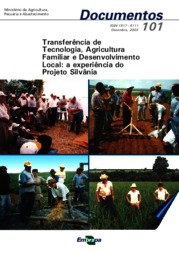Embrapa Meio Ambiente
 Publicador de conteúdo web
Publicador de conteúdo web
Publicações
 Busca de Publicações
Busca de Publicações
Transferência de tecnologia, agricultura familiar e desenvolvimento local: a experiência do Projeto Silvânia.
Autoria: ZOBY, J. L. F.; XAVIER, J. H. V.; GASTAL, M. L.
Resumo: ABSTRACT: The rural development has been associated to the modernization of the agriculture by the use or incorporation of new technologies to the productive process. However, it cannot just be faced as fruit of technological change, because the own adoption of technologies is dependent of external factors to the rural establishments. This work discusses the methodology used in the Project "The utilization of R&D approach for the development of the small agriculture in the area of Silvânia-GO", usually known as "Projeto Silvânia". The R&D approach can be defined as the experimentation in real scale and in collaboration with the farmers for the improvements technical, economical and social of the production systems and of the modalities of exploration of the place. The choice of R&D approach was based on the premise that it is not enough to generate technologies, to try in real conditions and to develop the techniques to allow to improve the operation and the productivity of the units of production. It should be tried, also, that the farmers that administer their businesses have the necessary resources to adopt those improvements and have interest in doing it. In R&D, the development strategies and the manners of organization of the farmers are object of studies jus as the operation or the production systems. That means that the technical innovation and the social are two complemental aspects and indissoluble of a same transformation process and for that they have to be considered. The principles that orientate the work are presented, as well as the following steps in the application of the methodology and the use tools. At the end, the results reached by the project are discussed and the main challenges for the use of the methodology.
Ano de publicação: 2003
Tipo de publicação: Folhetos
Unidade: Embrapa Cerrados
Palavras-chave: Adoção de Inovações, Agricultura Familiar, Análise de Dados, Desenvolvimento Rural, Diagnosis, Diagnostico, Extensão Rural, Innovation, Inovação, Organização, Pequeno Produtor, Produtor rural, Projeto Silvânia, Sistema de Produção, Tecnologia, Transferência, Transferência de Tecnologia
